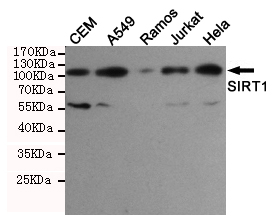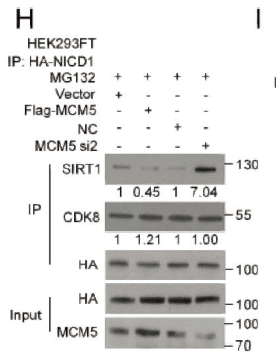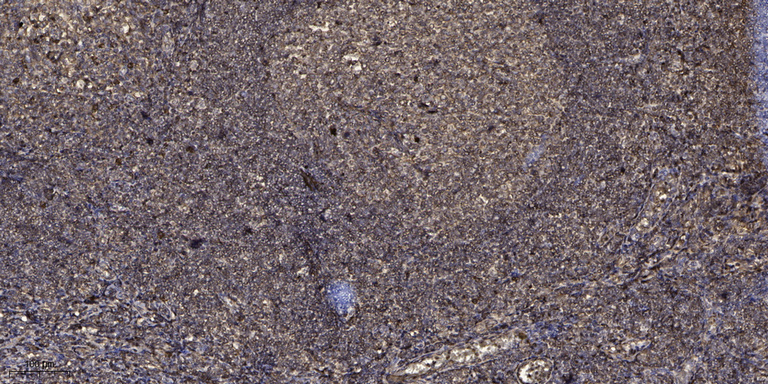SIRT1 Monoclonal Antibody
- Catalog No.:YM0578
- Applications:WB;IHC;IF;FCM;ELISA
- Reactivity:Human;Monkey
- Target:
- SIRT1
- Fields:
- >>Nicotinate and nicotinamide metabolism;>>Metabolic pathways;>>FoxO signaling pathway;>>AMPK signaling pathway;>>Longevity regulating pathway;>>Longevity regulating pathway - multiple species;>>Cellular senescence;>>Glucagon signaling pathway;>>Alcoholic liver disease;>>Amphetamine addiction;>>MicroRNAs in cancer
- Gene Name:
- SIRT1
- Protein Name:
- NAD-dependent deacetylase sirtuin-1
- Human Gene Id:
- 23411
- Human Swiss Prot No:
- Q96EB6
- Mouse Swiss Prot No:
- Q923E4
- Immunogen:
- Purified recombinant fragment of human SIRT1 expressed in E. Coli.
- Specificity:
- SIRT1 Monoclonal Antibody detects endogenous levels of SIRT1 protein.
- Formulation:
- Liquid in PBS containing 50% glycerol, 0.5% BSA and 0.02% sodium azide.
- Source:
- Monoclonal, Mouse
- Dilution:
- WB 1:500 - 1:2000. IHC 1:200 - 1:1000. IF 1:200 - 1:1000. Flow cytometry: 1:200 - 1:400. ELISA: 1:10000. Not yet tested in other applications.
- Purification:
- Affinity purification
- Storage Stability:
- -15°C to -25°C/1 year(Do not lower than -25°C)
- Other Name:
- SIRT1;SIR2L1;NAD-dependent protein deacetylase sirtuin-1;hSIRT1;Regulatory protein SIR2 homolog 1;SIR2-like protein 1;hSIR2
- Molecular Weight(Da):
- 82kD
- References:
- 1. Clin Cancer Res. 2009 Jul 1;15(13):4453-9.
2. Cell. 2009 Jul 23;138(2):389-403.
3. J Biol Chem. 2009 Oct 16;284(42):28762-74.
- Background:
- This gene encodes a member of the sirtuin family of proteins, homologs to the yeast Sir2 protein. Members of the sirtuin family are characterized by a sirtuin core domain and grouped into four classes. The functions of human sirtuins have not yet been determined; however, yeast sirtuin proteins are known to regulate epigenetic gene silencing and suppress recombination of rDNA. Studies suggest that the human sirtuins may function as intracellular regulatory proteins with mono-ADP-ribosyltransferase activity. The protein encoded by this gene is included in class I of the sirtuin family. Alternative splicing results in multiple transcript variants. [provided by RefSeq, Dec 2008],
- Function:
- catalytic activity:NAD(+) + an acetylprotein = nicotinamide + O-acetyl-ADP-ribose + a protein.,cofactor:Binds 1 zinc ion per subunit.,enzyme regulation:Inhibited by nicotinamide. Activated by resveratrol (3,5,4'-trihydroxy-trans-stilbene), butein (3,4,2',4'-tetrahydroxychalcone), piceatannol (3,5,3',4'-tetrahydroxy-trans-stilbene), Isoliquiritigenin (4,2',4'-trihydroxychalcone), fisetin (3,7,3',4'-tetrahydroxyflavone) and quercetin (3,5,7,3',4'-pentahydroxyflavone). RPS19BP1/AROS acts as a positive regulator of deacetylation activity.,function:NAD-dependent deacetylase, which regulates processes such as apoptosis and muscle differentiation by deacetylating key proteins. Deacetylates 'Lys-382' of p53/TP53 and impairs its ability to induce proapoptotic program and modulate cell senescence. Deacetylates TAF1B and thereby represses rDNA transcription by the RNA polymerase I. Involved in HES1
- Subcellular Location:
- Nucleus, PML body . Cytoplasm . Nucleus . Recruited to the nuclear bodies via its interaction with PML (PubMed:12006491). Colocalized with APEX1 in the nucleus (PubMed:19934257). May be found in nucleolus, nuclear euchromatin, heterochromatin and inner membrane (PubMed:15469825). Shuttles between nucleus and cytoplasm (By similarity). Colocalizes in the nucleus with XBP1 isoform 2 (PubMed:20955178). .; [SirtT1 75 kDa fragment]: Cytoplasm . Mitochondrion .
- Expression:
- Widely expressed.
Alpha-lipoic acid upregulates SIRT1-dependent PGC-1α expression and protects mouse brain against focal ischemia. NEUROSCIENCE Neuroscience. 2014 Dec;281:251 WB,IHC Mouse 1:200, 1:200 brain,control cortex
- June 19-2018
- WESTERN IMMUNOBLOTTING PROTOCOL
- June 19-2018
- IMMUNOHISTOCHEMISTRY-PARAFFIN PROTOCOL
- June 19-2018
- IMMUNOFLUORESCENCE PROTOCOL
- September 08-2020
- FLOW-CYTOMEYRT-PROTOCOL
- May 20-2022
- Cell-Based ELISA│解您多样本WB检测之困扰
- July 13-2018
- CELL-BASED-ELISA-PROTOCOL-FOR-ACETYL-PROTEIN
- July 13-2018
- CELL-BASED-ELISA-PROTOCOL-FOR-PHOSPHO-PROTEIN
- July 13-2018
- Antibody-FAQs
- Products Images
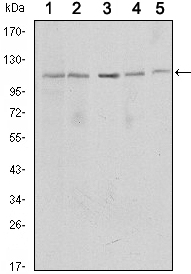
- Western Blot analysis using SIRT1 Monoclonal Antibody against MCF-7 (1), Jurkat (2), HeLa (3), HEK293 (4) and A549 (5) cell lysate.
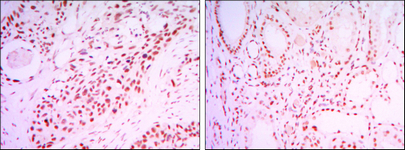
- Immunohistochemistry analysis of paraffin-embedded lung cancer tissues (left) and kidney cancer tissues (right) with DAB staining using SIRT1 Monoclonal Antibody.
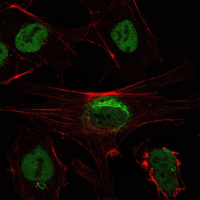
- Immunofluorescence analysis of NTERA-2 cells using SIRT1 Monoclonal Antibody (green). Red: Actin filaments have been labeled with Alexa Fluor-555 phalloidin.
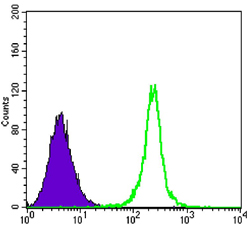
- Flow cytometric analysis of K562 cells using SIRT1 Monoclonal Antibody (green) and negative control (purple).
